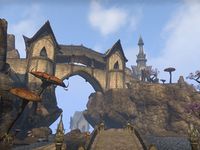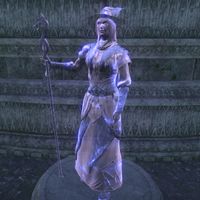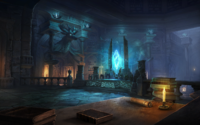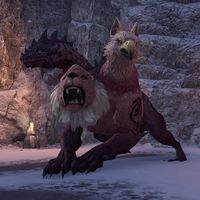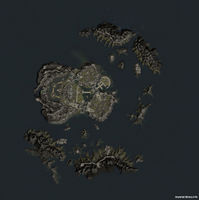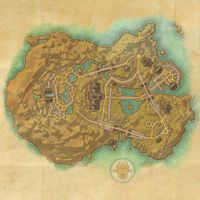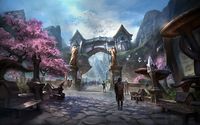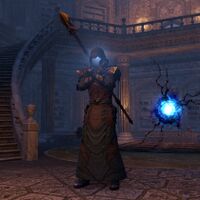Lore:Eyevea
| Eyevea | |
|---|---|
| Type | Island |
| Continent | Tamriel |
| Province | Summerset Isles |
| Appears in | ESO |
Eyevea (the long-lost Sanctuary)[1] is a small island in the Abecean Sea, far west of mainland Tamriel. Geographically it is part of the Summerset Isles archipelago, found to the northwest of the main island, although it is owned by the immortal Arch-Mage Shalidor of Skyrim, who bought it from the Altmer. It was once transported to the Shivering Isles until its return to Nirn during the Planemeld.
History[edit]
Eyevea was always a beautiful site, and the Altmer traded the outlier island to Shalidor for baubles and minor artifacts "of no real consequence".[1] In the early First Era, Shalidor established the island as a retreat and sanctuary for all mages. Altmeri architecture was used in the construction of the island's facilities, which included docks, workshops, bridges and halls. However, sometime around the Twenty-Third Century of the First Era,[2][nb 1] Shalidor wagered for Eyevea for the Daedric Prince Sheogorath's Folium Discognitum, a tome of knowledge which he had been obsessed with obtaining. Shalidor lost the bet, and the island was duly spirited away to Shivering Isles, where it would remain for thousands of years. It can be assumed that the island was therefore subjected to the Greymarch, possibly several times.[nb 2] Its time in the realm also seemingly resulted in the introduction of indigenous Mushroom Trees to the island.
Shalidor went on to regret trading away the island, feeling that he had been tricked by the Mad God. In 2E 582, the Mages Guild was expelled from Cyrodiil and became fractured due to the Three Banners War, despite claiming neutrality in the war. Although he had had nothing to do with the guild in life, Shalidor returned to the affairs of mortals in order to win back Eyevea from Sheogorath so that it could serve its original purpose and act as a sanctuary for the guild.[3]
Sheogorath agreed to give Shalidor the means of reclaiming the island, if his champion agreed to complete four trials for the Prince's amusement. An adept of the Mages Guild agreed to undertake the Trial of Eyevea, and was then subjected to various inane tests. At the end of each trial, the guild was given a tome containing clues to returning Eyevea to Mundus. Valaste, the guild's Master of Incunabula, took on the burden of decrypting these books, as Shalidor himself was forbidden to read them.[4][5][6] The guild was eventually successful in restoring the island, but as a final test Sheogorath neglected to remove Eyevea's Daedric guardians before returning it. As such, it was swarming with Golden Saints and Dark Seducers, which needed to be cleared out. With that done, the adept was forced to fight Haskill to finally clear the island of Sheogorath's influence.[7]
The island was subsequently occupied by the Mages Guild, which opened portals in every guildhall in Tamriel to allow access. As well as acting as a center of magical learning, Eyevea also became home to a guild vault, and merchants were allowed to peddle their wares as long as they paid a tithe to the guild. War-related infighting proved to be a problem due to the diverse range of guild members the island attracted, although guildmaster Vanus Galerion took measures to prevent it.[8] The island also contained legendary crafting sites, where items crafted would obtain certain innate magical traits due to the creative echoes of the original master crafters.[9] During the concurrent Three Banners War, High King Emeric was privately highly supportive of the island,[10] while the Crowns were seeking to ban any Guild member that studied in Eyevea from working with the military.[11]
The Scholarium[edit]
Creation[edit]
The Scholarium was an immense library deep beneath Eyevea, situated in the cleared out ancient ruins within the caverns underneath the island's surface.[12] It was described as a space filled with an immense amount of bookshelves, each shelf lined with tomes that held knowledge, magic, and arcane artistry, long lost to Tamriel.[13] The library contained texts in a variety of languages such as Aldmeris, Atmoran, Yokudan, Old Nedic, and Orcish. It also included metal plates carved with runes in Dwemeris and was even theorized to hold texts in some previously unknown dialects of Ehlnofex. The contents of the library were difficult to decipher as many of the tomes were written in forgotten languages, magical script, secret code, or a combination of all three.[14][15][16]
When Archmage Ulfsild the Evergreen first transported herself to Eyevea via portal magic to seek out Shalidor, her spell deposited her in the ruin filled caves beneath the island's surface, which had been cleared even than.[12] Over time, during her stay on the island, Ulfsild added all sorts of books thus creating her library.[17] The texts the library contained covered more than magic, with entire sections dedicated to other topics such as First Era cookbooks, poetry from Atmora, and bawdy limericks, a variety owed to Ulfsild's eagerness to follow the hunt for knowledge wherever it led.[18]
At some point after 1E 2250,[2][19] Ulfild encountered the Luminaries of Magic, passed their trials, and developed a bond with them, leading them to bind their realms to the Scholarium itself.[20][21][22][23][24][25] Thus doors leading to the Wing of the Indrik, Wing of the Gryphon, Wing of the Dragon, and Wing of the Netch were created in the Scholarium itself.[26][27][28][29]
Within the Scholarium Ulfsild collaborated with the Luminaries to create Scribing, the "metamagical theoryset"[30] which was the precursor to the modern spellcrafting system.[26][UOL 1] With the strength of the Luminaries fueling it, the Scribing Altar could achieve incredible feats of magic, allowing it to "shape the very heart of magic itself" and translate its very essence into mortal hands with the Luminary as the intermediary, thereby changing, or rewriting, both the magic and the mortal, as the practitioner scrawls their soul upon the page. As beings of pure magic the Luminaries are said to have understood magic in a way mortals never could and so, their power, freely given, allowed one to access arcane mysteries most could only dream of. Indeed, Scribing was said to have been somehow destined to channel the power of the Luminaries from the start.[26][20]
The power of the Indrik infused every drop of ink, every sheet of parchment, every whorl and dot upon the pages of the texts used for the Scribing process.[20] The Gryphon, sure in himself and direct in his actions, was associated with the development of Focus Scripts, arcane scripts which defined what effect the Scribed magic would have. The Netch worked with Ulfsild to create the Luminous Ink, the substrate of power into which the magic of the Scribing altar was vested, and served as the binding agent that drew magicka and intent together upon the page. The Dragon, keen of mind and eager to listen, was associated with the development of Signature elements, Scripts that could adapt to the magical and fighting styles of the person holding the parchment, named for all the ways in which Scribing could interact with the goals and magics of other disciplines that Ulfsild had discovered.[31]
During this time the Scholarium also became guarded by animated constructs designed by Ulfsild and the Luminary Gryphon, though their designs were not finalized before the loss of the island.[28][32]
At some point after 1E 2250, [2][19][33] the Scholarium was lost along with Eyevea, which it was located under, transported to the Shivering Isles due to a bargain Shalidor made with the Daedric Prince Sheogorath in exchange for the Folium Discognitum.[26][1]
Knowing that nothing she or the Luminaries could do would outpace the greed of a Daedric Prince, Ulfsild first froze the Luminary Gryphon in a tempest of ice, the magic of which she tied to a ward she left behind. This prevented the enraged Luminary from confronting Sheogorath, a being against whom even he was no match, while also preventing the Prince from discovering the Scholarium and Luminaries, which would've been disastrous.[32][28][34][26][35][36]
Ulfsild than used what time she had to enact a final plan meant to assure that Scribing would not become lost to the world. She used part of her own soul in a ritual that combined her spirit and a copy of her mind from that moment in time, flashing them upon the great wellspring of arcane power she'd gathered in the Scholarium's Scribing Altar, to create a new Luminary of Magic through a ritual described as the ultimate act of Scribing.[26][37][38] Thus the Luminary Crow was born. With her birth she chose the shape of her physical form, and her personal realm, the Wing of the Crow, was also shaped and hewn into existence in the same manner, and became connected to the Scholarium via its own door.[20][26][39]
With the doors closed, the altar became dormant. Without that beating heart, the mastery of Scribing was believed to stagnate.[26] The Scholarium itself was not discovered, however, for it had been warded against mages, Princes, and powers, long ago, and those defenses held strong even in the Shivering Isles. The Crow did not have much time to speak with Ulfsild, her other self, before the doors were sealed.[26]
Rediscovery of Scribing[edit]
In 2E 582, either before or after Eyevea was returned to Tamriel by Shalidor and the Mages Guild, the Scholarium was rediscovered by a group of knights from the Order of the Lamp. During their arrival, complications arose, necessitating the sealing of the doors to prevent a catastrophe, as the once dormant altar became unstable, threatening the lives of everyone present. The disaster was prevented due to the intervention of the Vestige, who replaced the unstable focusing crystal. This potentially also prevented the discovery of the Scholarium by Sheogorath, an event which would've been catastrophic.[26][40]
After the magic was calmed, the Scholarium's caretaker, the Luminary Crow, directed the Vestige to seek out the other Luminaries and gain their support in order to return their strength to the altar. An act equated to inheriting Ulfsild's legacy and leaving a mark on spellcraft itself.[26]
The Inheritor of the Scholarium retraced Ulfsild's footsteps, guided by her echoes and the True Sight Lens she'd left behind to allow them to see magicka as she could, discovering the fable and keys, breaking the wards, and entering the Wings of the Indrik, the Dragon, the Gryphon, and the Netch, to reconnect the Scholarium with them. The Luminaries gave the Inheritor a series of challenges to complete in order to prove themselves as Ulfsild's Inheritor. After their tasks were completed, the Luminaries agreed to lend their power.[41][42][32][20][26]
With their trials completed, the Luminaries granted their Sigils to the Inheritor. Placed at the altar, the Sigils restored the connection between the realms of the Luminaries and the Scholarium, and their strength flowed into the altar once more.[41][27][43][28][29] This reconnection led to the great power of the Luminaries causing new Ley Line activity across Tamriel, thus making Affix Scripts, Signature Scripts and Luminous Ink appear across the land[20][44][45][46][47]
With the support of the other Luminaries now assured, the Crow revealed the truth. She was the final Luminary, created by Ulfsild herself, and the last who could lend her power to the Scribing Altar. The chaotic magic that had originally led to the rediscovery of the Scholarium was a result of the Crow's own presence, as Ulfsild's ritual had never been fully refined due to the urgency of the situation not allowing enough time for it.[26]
In the Wing of the Crow the Vestige underwent the final trial to be declared the inheritor of Ulfsild's legacy. Within the Luminary Crow's replica of Labyrinthian, the Inheritor navigated the invisible path through the maze aided by the Fox, who had been tasked to help by Ulfsild herself,[34] broke the wards, and bested the Chimera Aut'arioth, which the Crow had summoned to serve as the final challenge. The Dragon and the other Luminaries than appeared, and acknowledged the Vestige as the inheritor of Ulfsild's legacy. With the final test completed, the Crow guided the Inheritor to retrieve her own Sigil, which Ulfsild had taken with her when she departed, so it too could be added to the Scribing Altar, amplifying its power further.[41][39] Knowing the Inheritor had other adventures calling to them, the Crow chose Order of the Lamp Votary Nahlia to act as the Scholarium's new caretaker. Thus Scribing returned to Tamriel.[26][40]
Vanus Galerion was particularly enthusiastic of the possibilities it would open up, with early ideas being altars being installed in every guild hall, or that Scribing will perhaps one day be taught in the wilds.[2] The legacy of Ulfsild's lived on, with Scribing eventually evolving into the modern Spellcrafting systems.[UOL 1]
Gallery[edit]
Bird's-eye view of Eyevea circa 2E 582
Notes[edit]
See Also[edit]
- For game-specific information, see the ESO article.
References[edit]
- ^ a b c Arch-Mage Shalidor's dialogue in ESO
- ^ a b c d e Loremaster's Archive - Scribing — Votary Nahila
- ^ Events of Long Lost Lore in ESO
- ^ Events of Simply Misplaced in ESO
- ^ Events of Circus of Cheerful Slaughter in ESO
- ^ Events of Chateau of the Ravenous Rodent in ESO
- ^ Events of The Mad God's Bargain in ESO
- ^ By Order of Guildmaster Vanus Galerion — Vanus Galerion
- ^ Master Assistant Materials Acquirer Pacrooti Answers Your Questions — Pacrooti
- ^ Emmandic Oltz's dialogue in ESO
- ^ Delkash's dialogue in ESO
- ^ a b Our Story, Part III — Ulfsild
- ^ The Scholarium's loading screen in ESO
- ^ First Letter to the Mages Guild, Draft Copy — Adept Irnard Rirnil
- ^ Second Letter to the Mages Guild, Draft Copy — Adept Irnard Rirnil
- ^ Third Letter to the Mages Guild, Draft Copy — Adept Irnard Rirnil
- ^ Llaren's Addition to the Scholarium
- ^ Votary Llaren's dialogue in ESO
- ^ a b c Mages Guild Charter
- ^ a b c d e f The Indrik's dialogue in ESO
- ^ Ulfsild's Log: The Indrik — Ulfsild
- ^ Ulfsild's Log: The Gryphon and the Fox — Ulfsild
- ^ Ulfsild's Log: The Netch — Ulfsild
- ^ Ulfsild's Log: The Dragon — Ulfsild
- ^ Ulfsild's Notes: The Impossible Riddle — Ulfsild
- ^ a b c d e f g h i j k l m n The Crow's dialogue in ESO
- ^ a b The Wing of the Dragon quest in ESO: Gold Road
- ^ a b c d The Wing of the Gryphon quest in ESO: Gold Road
- ^ a b The Wing of the Netch quest in ESO: Gold Road
- ^ The Largesse of the Archmagister — Chronicler Firandil
- ^ How to Scribe — Ulfsild
- ^ a b c The Gryphon's dialogue in ESO
- ^ Ulfsild's Log: The Indrik — Ulfsild
- ^ a b The Fox's dialogue in ESO
- ^ Ulfisild's Echo of Regret's dialogue in ESO
- ^ Ulfisild's Echo of Loyalty's dialogue in ESO
- ^ Fable of the Crow
- ^ Ulfsild the Evergreen's dialogue in ESO
- ^ a b The Wing of the Crow quest in ESO: Gold Road
- ^ a b The Second Era of Scribing quest in ESO: Gold Road
- ^ a b c The Dragon's dialogue in ESO
- ^ The Netch's dialogue in ESO
- ^ The Wing of the Indrik quest in ESO: Gold Road
- ^ Sigil of the Dragon Analysis
- ^ Sigil of the Indrik Analysis
- ^ Sigil of the Gryphon Analysis — Chronicler Firandil
- ^ Sigil of the Netch Analysis
Note: The following references are considered to be unofficial sources. They are included to round off this article and may not be authoritative or conclusive.
| ||||||||||||||||||||
